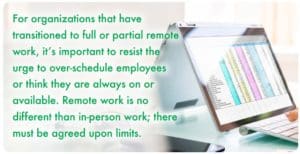Three keys to ensuring inclusion and belonging for both remote and in-office employees.
By Amy E. Hull
Well, 2022 has surely arrived with another grand entrance and another year of challenges as the workforce continues to address COVID-19 and all its variant friends (hard eyeroll). At the onset of this awful pandemic, many businesses had no choice but to temporarily close, only to chaotically reopen as the pandemic kept rewriting the rules of the game. While many businesses decided it was more profitable and/ or inclusive to allow employees to continue to work remotely, there was a third choice of offering both opportunities, a hybrid work environment in which employees had choice. How novel! Personalized learning has been a cornerstone of instructional strategies in schools across America and now, with a new focus on flexible work, it has migrated into the business community. At the surface, personal flexibility should be an unalloyed positive, but is it? As remote and hybrid work environments become the norm, CHROs, DE&I chiefs, and executive leadership must pay attention to three critical points to ensure the new world of work is equitable and inclusive.
1. Remote/hybrid work does not mean 24/7 access to employees. There can be a knee-jerk reaction by some managers who think working from home is a luxury, and that was mostly true in pre-pandemic times. Flex work was often considered a perk. Flexibility is no longer a perk. It’s the name of the game in 2022 for the mental health and well-being of everyone. People have experienced these last years in a variety of ways, from losing loved ones, to dealing with rolling school closures, to pervasive feelings of loneliness. Organizations are all still struggling to re-assert some semblance of normalcy. For organizations that have transitioned to full or partial remote work, it’s important to resist the urge to over-schedule employees or think they are always on or available. Remote work is no different than in-person work; there must be agreed upon limits. The more flexible the workplace can be, the better.

2. Taking time zones into consideration increases inclusion. Inclusion has been proven to increase belonging, engagement, and productivity in the workplace. It’s important to shore up the gains that were made during the transition to a remote or hybrid workplace. What does this mean? If company headquarters are in Ohio and TA leaders are hiring remote workers across the country, don’t expect new remote West Coast employees to wake up at 4 a.m. for the Monday morning meeting. The last two years acted as a live, real-time case study in proving that it’s work productivity and results that matter; it’s how or when work gets done. Organizations that used their creativity to grow during the shutdowns gave employees room and flexibility to use their time better, be more engaged, and increase their productivity.
3. Globalize workforce programs and outreach initiatives. As the world shifts to whatever the new normal ends up being, don’t give up on fun. Remember, people still want to feel a sense of community at work. In fact, many are searching for more opportunities to stay connected. That fundamental need doesn’t end simply because employees aren’t physically present at an office every day. Employee resource groups that develop to increase outreach and community service are more important than ever. In 2022, it is critical to expand these programs into regional segments or chapters. Think about how the business can further support the communities in which employees live and work. People are starving for connection. A great way to respond to this need is by empowering employees to give back and volunteer.
Forbes is now estimating that half of the workforce will be remote by the end of 2022. While it is important to plan for the flexibility, inclusion, belonging, and diversity of employees in the new remote/hybrid workforce, let’s not forget about the other half of workers who are going into a physical space to work, be that an office or a warehouse. It may take extra effort, or extra investment, but inclusion and belonging for both remote and in-person employees will pay off. There’s been enough attrition. Let’s leave The Great Resignation behind and work toward a future of growth and inclusion for all.
Amy E. Hull is director and head of diversity, equity, and inclusion for Paycor.














